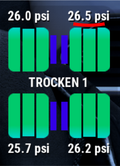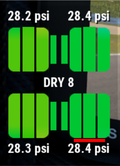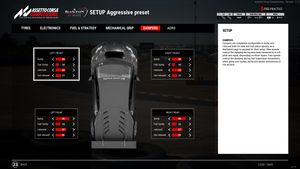Car Setups and Pitstop
Car Setup
You have a choice of preset setups or you have the option to go directly to the current setup:
- Safe Preset Setup
- Aggressive Preset Setup
- Wet Preset Setup
- Current Setup
Tyres
Tire Pressures
The current psi values are displayed in the tire app. Zursätzlich is represented by the different heights, at the three large bars, the differences in the three tire zones. At the front wheels above and at the rear wheels below.
- Drive 10 laps and watch the tire pressure. At the end of the curve and at the end of the longest straight.
- good values are dry 28,0 - 28,5 psi and wet / cold ~30 psi
- The default settings usually give you lower values. Increase the values in the tire setup menu to compensate for this difference.
- drive a few more rounds and watch the psi values.
Tire Temperatures
In the tire app, the three temperature zones (OMI or IMO) are visualized by three bars. Their color areas change depending on the temperature. Turquoise - Blue - Light Green - Green - Orange - Red. The temperature values can be seen either in the cockpit (depending on the vehicle type) or in the setup menu
| Property | Values | Description |
|---|---|---|
| Last Readings | Snapshot of the states of your wheels | |
| O M I / I M O | 80 84 88 | Temperatures (°C) of the Tires: (O)utside (M)iddle (I)nside or (I)nside (M)iddle (O)utside |
| psi hot | 27.3 | highest recorded pressure |
| wear | 2.95 2.94 2.94 | Degree of wear (O M I / I M O) |
| Tires | Adjustments for your wheels / suspension | |
| psi | 25.2 psi | Pressure when tire is not stressed |
| toe | 0.2° | the position of the wheel to the direction of travel |
| camber | -4.1° | the position of the wheel to the roadway / https://en.wikipedia.org/wiki/Camber_angle |
| caster | -10.6° | Only on the front wheels! https://en.wikipedia.org/wiki/Caster_angle |
Eletronics
| Property | Values | Description |
|---|---|---|
| TC | 0 - ? | Traction Control |
| ABS | 0 - ? | Anti-lock braking system |
| ECU Map | Engine control unit | |
| telemetry laps | 0 - 30 | Here you set the number of laps to be recorded for the tool MoTeC. |
| TC2 |
Fuel and Strategy
| Property | Values | Description |
|---|---|---|
| Wear | ||
| Grain | ||
| Blister | ||
| Flat Spot | ||
| pad wear | ||
| dirc wear | ||
| Fuel and Tyre | ||
| fuel | 1 - ? | |
| tyre | choose DRy or Rain Tyre | |
| tyre set | 1 - ? | |
| front brakes | 1 - 4 | choose the ↓Brake Pads on front axle |
| rear brakes | 1 - 4 | choose the ↓Brake Pads on rear axle |
| fuel last lap | Gasoline consumption in the last lap | |
| Pitstop Strategy | ||
| N°. | ||
| fuel to add | ||
| tyre | ||
| tyre set | ||
| left front | ||
| rigth front | ||
| left rear | ||
| right rear | ||
| front brakes | 1 - 4 | choose the ↓Brake Pads on front axle |
| rear brakes | 1 - 4 | choose the ↓Brake Pads on rear axle |
Brake pads
| Value | Description |
|---|---|
| 1 | Very aggressive friction coefficient, max braking performance, aggressive disc and pad wear. Pedal modulation can be tricky if out of temperature or as it wears down. Use in hotlap and qualifying sessions, sprint races and can withstand 3 hours races. Risky and dangerous to use over 3 or 4 hours because the pads will wear down, overheat and lose linearity in brake pedal feel. |
| 2 | Very Good friction coefficient, very good braking performance, good disc and pad wear. Pedal modulation almost always good and linear, good feedback while overheating and gradual wear. Perfect for endurance racing, but can also be used in hotlap , qualifying sessions as well as sprint races as what it loses in performance, regains in braking modulation and predictability. The default choice for long endurance races, easily makes 12 hours and can make 24 hours race too with a bit of care. Will also overheat and lose linearity in brake pedal feel when worn out, but in a more predictable way and after much longer stints. Because of the lower friction, you could possibly use smaller brake ducts. |
| 3 | Moderate friction coefficient, braking zones can be longer in dry, very moderate disc and pad wear. Excellent pedal modulation also in cold ambient conditions, very linear pedal feedback. Excellent choice for wet conditions and very long endurance races. Very predictable and easy to modulate brake pad. Because of the lower friction, you should use smaller brake ducts. |
| 4 | extreme aggressive fiction coefficient. Max braking performance, extremely aggressive disc and pad wear, bad cold performance. This is a sprint race pad that can last about an hour but will show worse pedal feel, worse performance and overheating towards the end of the one hour stint. Those kinds of pads are not used in endurance racing, but included for demonstration purposes. |
Mechanical Grip
| Property | Values | Description |
|---|---|---|
| Front | ||
| antiroll bar | ||
| brake power | ||
| brake bias | ||
| steer ratio | ||
| Rear | ||
| antiroll bar | ||
| preload differential | ||
| Rear/Front - Left/Right | ||
| wheel rate | ||
| bumpstop rate | ||
| bumpstop range | ||
Dampers
| Property | Values | Description |
|---|---|---|
| Rear/Front - Left/Right | ||
| bump | stops the springs oscillation inward. A higher number wil dampen the compression at a slow rate more. | |
| fast bump | A higher number wil dampen the compression at a high rate more. | |
| rebound | stops the springs oscillation outward. A higher number wil dampen the decompression at a slow rate more. | |
| fast rebound | A higher number wil dampen the decompression at a high rate more. | |
Aero
| Property | Values | Description |
|---|---|---|
| Rear | ||
| rear ride height | high is more forgiving, low is faster but tight. | |
| rearwing | a high number Increases drag,rear downforce, understeer and stability but lowers the topspeed and acceleration. | |
| brake ducts | Has effect on how fast the discs cool down and earodynamica. low number=cooldown slow, high number= cooldown fast. | |
| Front | ||
| front ride height | high is more forgiving, low is fast but tight. | |
| splitter | increases oversteer, decreases understeer, lowers topspeed. | |
| brake ducts | Has effect on how fast the discs cool down and earodynamica. low number=cooldown slow, high number= cooldown fast. | |
| Fuel Load Test | ||
| temporary fuel | 0 litre - ? litre | Simulates the weight of the contents of the tank and the impact on the aero model of the car. Depending on where the tank is located in a car, it has different effects. |
| Front Aero Variation | ||
| Base ride height | xx rear - xx front x.x% | |
Pitstop
A pit stop to refuel missing gas or repair damage is possible in practice, qualifying and racing. A driver can set his pit stop strategy in the vehicle setup (Fuel and Strategy) and change it while driving in the multifunction display (MFD). In a race without a compulsory pit stop, the pit lane is opened when the leader of the race has finished the first lap. In the middle of the lower part of the screen, the message of the race control is displayed: RCTL Pitlane is open
Server Configuration, see here: →eventRules.json
Mandatory Pitstop
- Variant 1: mandatory Pitstop possible throughout the race.
- Variant 2: mandatory Pitstop Window is limited in time. (Pitstop for damage repair always possible)
- Example: Race: 18 min / Window: 6min = from 6. Minute to 12. Minute

- What can be required for a mandatory pit stop?
- refueling
- change wheels
- driver swap
Server Configuration, see here: →eventRules.json
Driver Swap
(in MP: Swapping the riders works, but the operation is not intuitive and faulty! Last time tested: 17.11.2019 ACCv1.1.2)
Several drivers (in Blanpain real: 2-4) can form a team. All drivers can be on the server. The waiting drivers are not considered spectators in the sense of →Spectator Mode.
Using the Pit strategy page in the ( M )ulti(F )unctional( D )isplay (key: insert), the driver can assign a driver swap which will be automatically executed during the next pitstop.
Server Configuration, see here: →eventRules.json and →entylist.json
References
- Suspension and Spart... setups, I mean setups! - Kunos Forum - ACC Blog von Aristotelis
- ECU maps implementation - Kunos Forum - ACC Blog von Aristotelis
- Brake ducts and Tyre damage - Kunos Forum - ACC Blog von Aristotelis
- Bumpstop telemetry in the setup screen - Kunos Forum - ACC Blog von Aristotelis
- https://en.wikipedia.org/wiki/Caster_angle
- https://en.wikipedia.org/wiki/Camber_angle
- MSRL - Midnight Sim Racing Liga - YouTube Playlist: MSRL SetupGuide (German):










